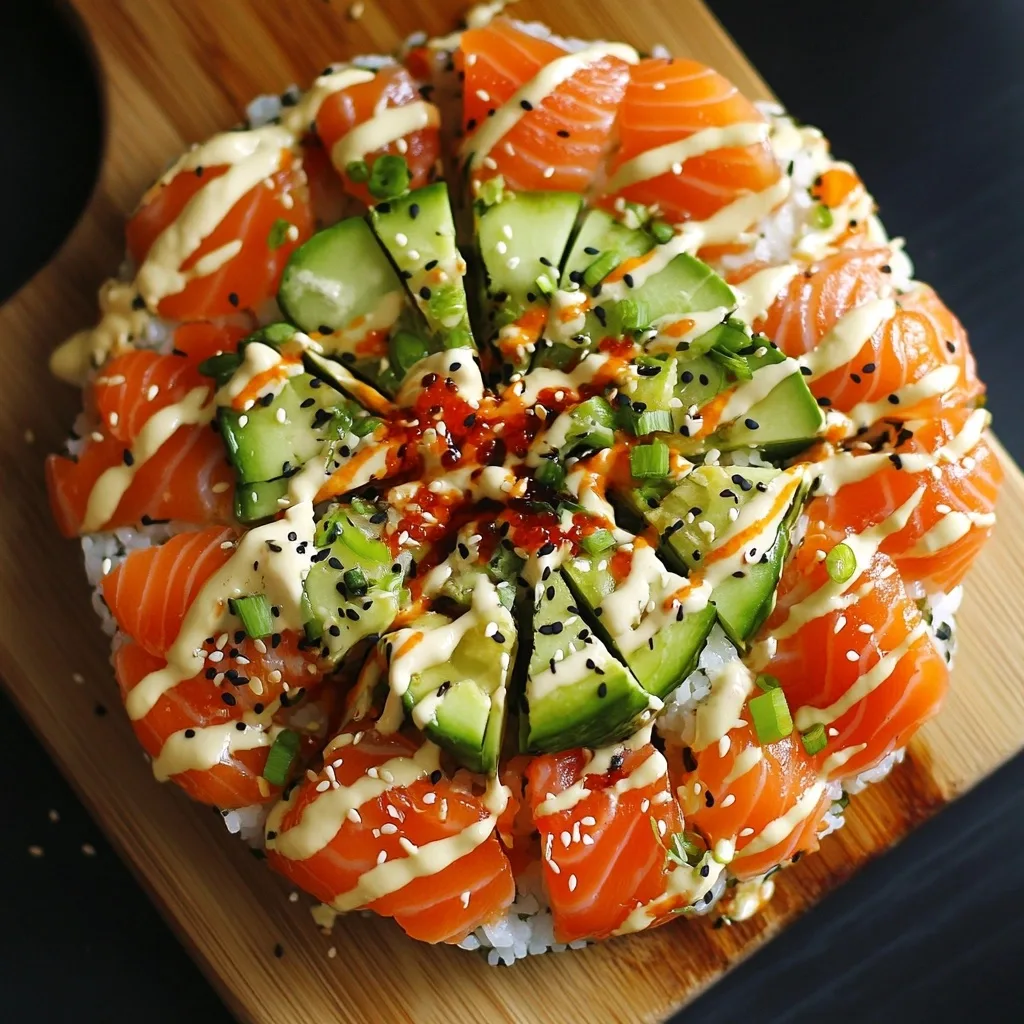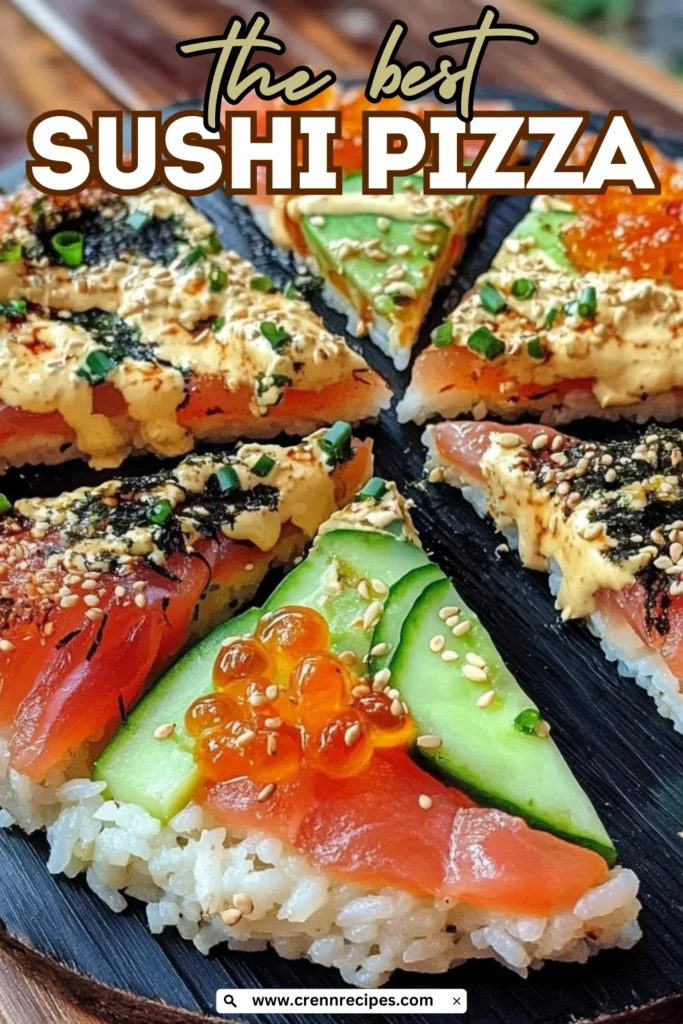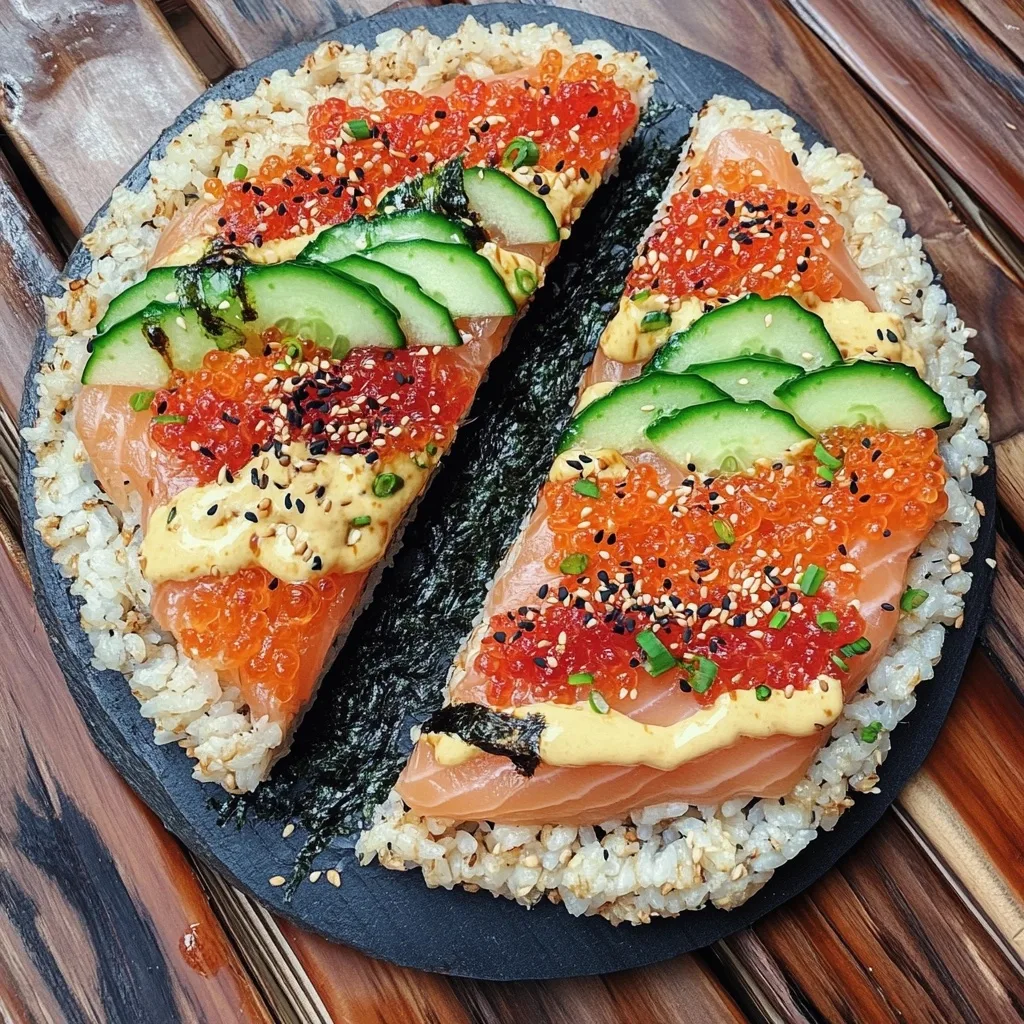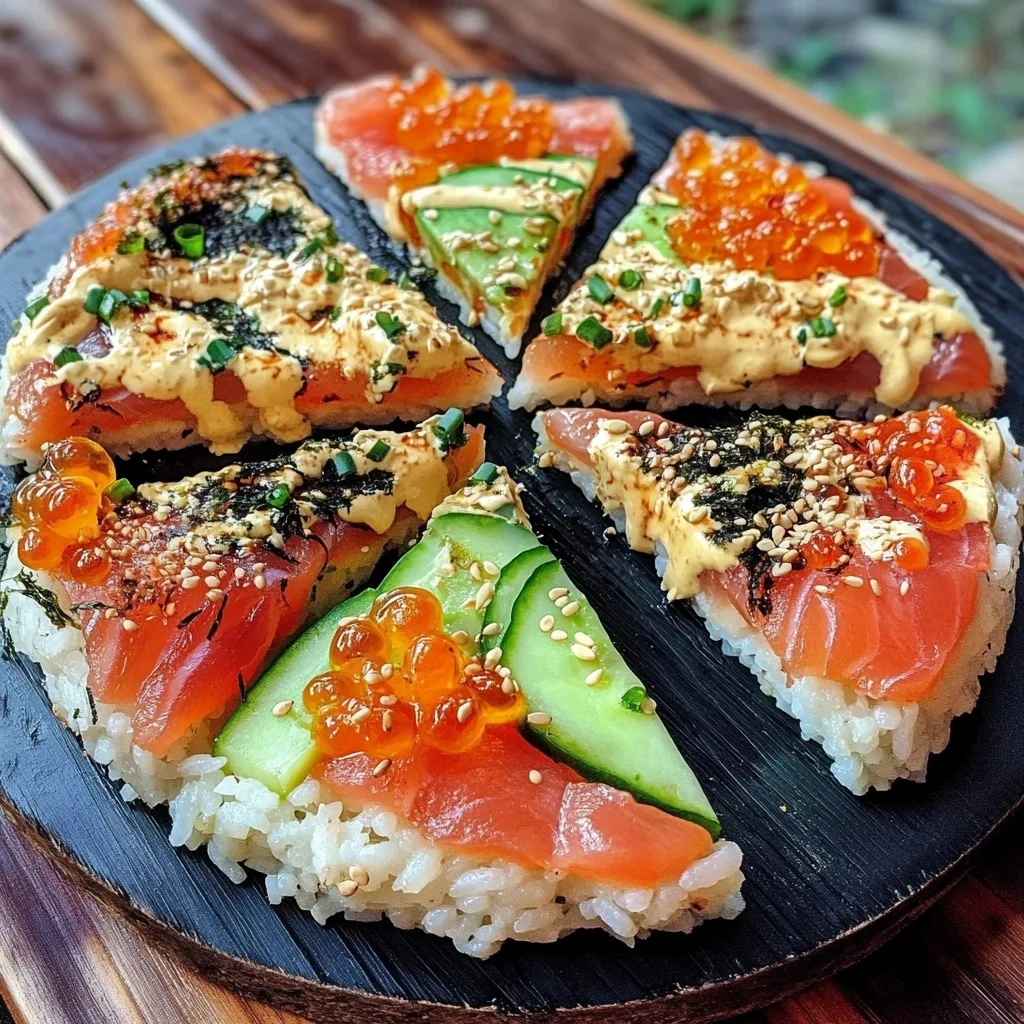Transform your dining experience with this unique Sushi Pizza recipe—a perfect marriage of Japanese flavors and American creativity that will impress family and friends at your next gathering!
Introduction to Sushi Pizza
When two culinary worlds collide, magic happens on your plate. Sushi Pizza represents the beautiful harmony that can be achieved when traditional Japanese cuisine meets American innovation. This delightful fusion dish takes the beloved flavors of sushi—fresh fish, seasoned rice, and vibrant toppings—and presents them in a familiar, shareable format that’s perfect for family gatherings or entertaining friends who might be hesitant about traditional sushi.
Unlike conventional sushi that requires special rolling techniques, Sushi Pizza is approachable for home cooks of all skill levels. The crispy rice “crust” forms a sturdy base for premium toppings like sushi-grade fish, creamy avocado, and zesty sauces. Each slice delivers that perfect balance of textures and flavors: crunchy edges, tender rice, buttery fish, and punchy seasonings.
What makes Sushi Pizza particularly special is its versatility. While maintaining the essence of Japanese cuisine—quality ingredients, thoughtful presentation, and balanced flavors—it adapts to American sensibilities with its pizza-like structure and customizable toppings. It’s the ideal introduction for sushi newcomers while still satisfying experienced sushi enthusiasts.
Whether you’re hosting a casual family dinner or an elegant cocktail party, this Sushi Pizza recipe will elevate your menu with minimal effort and maximum impact. Let’s dive into this culinary adventure and create a dish that will have everyone reaching for seconds!
The History and Evolution of Sushi Pizza
Origins of This Unique Fusion
Sushi Pizza isn’t just a random culinary experiment—it has a fascinating origin story that spans continents. While traditional sushi has been perfected over centuries in Japan, Sushi Pizza emerged much more recently as part of the global fusion food movement of the 1990s.
Most food historians credit Canadian chef Kaoru Ohsada with creating the first version of Sushi Pizza in Toronto around 1993. His creation featured a fried rice patty topped with salmon and various traditional sushi garnishes. The dish quickly gained popularity across North America, with regional adaptations appearing in major cities from Los Angeles to New York.
The development of Sushi Pizza perfectly illustrates how cuisine evolves when cultures intersect. Japanese immigrants brought their culinary traditions to North America, where these techniques and flavors met local preferences for accessibility and shared dining experiences. The result was an innovative dish that honors its Japanese roots while embracing a format familiar to Western diners.
How Sushi Pizza Differs from Traditional Sushi
While traditional sushi and Sushi Pizza share key ingredients, they differ significantly in structure and presentation:
- Form Factor: Traditional sushi comes in various forms—rolls (maki), hand-formed pieces (nigiri), or bowls (chirashi)—while Sushi Pizza adopts a flat, round shape meant to be sliced and shared like its Italian namesake.
- Rice Preparation: Both use vinegar-seasoned rice, but Sushi Pizza takes an extra step by crisping the rice to form a sturdy “crust,” adding a textural element absent in traditional sushi.
- Topping Application: Rather than the precise, minimalist approach of traditional sushi, Sushi Pizza embraces abundance with layers of toppings arranged across the entire surface.
- Eating Experience: While traditional sushi is typically enjoyed in discrete pieces with soy sauce for dipping, Sushi Pizza incorporates sauces directly on the dish and is eaten in triangle slices.
This creative adaptation has made sushi flavors more approachable for many diners while preserving the essence of what makes Japanese cuisine special—quality ingredients, thoughtful preparation, and visual appeal.

Essential Ingredients for Perfect Sushi Pizza
Selecting the Right Rice
The foundation of any great Sushi Pizza is properly prepared sushi rice. This isn’t just any rice—it requires specific varieties and careful seasoning:
Rice Variety: Short-grain Japanese rice (sometimes labeled as “sushi rice”) is non-negotiable. Its high starch content creates the sticky texture necessary for both shaping and crisping the crust. Brands like Nishiki, Kokuho Rose, or Tamaki Gold are excellent choices.
Cooking Technique: The rice should be rinsed thoroughly until the water runs clear to remove excess starch. Use a 1:1.1 ratio of rice to water for the perfect texture—fluffy yet sticky. A rice cooker provides the most consistent results, but stovetop cooking works well with careful attention.
Seasoning: The vinegar mixture (known as “sushi-zu”) is critical for authentic flavor. The balance of rice vinegar, sugar, and salt transforms plain rice into proper sushi rice with that characteristic tangy-sweet profile that complements the toppings.
Choosing Sushi-Grade Fish
The star of any Sushi Pizza is undoubtedly the fish:
Quality Matters: Always use sushi-grade (sometimes called “sashimi-grade”) fish purchased from reputable fishmongers or Japanese markets. This designation indicates the fish has been frozen according to FDA guidelines to eliminate parasites and is safe to consume raw.
Popular Options: While this recipe suggests salmon or tuna, other excellent choices include yellowtail (hamachi), sea bass, or even cooked options like shrimp or unagi (freshwater eel) for those uncomfortable with raw fish.
Freshness Indicators: Look for fish with a clean ocean smell (never “fishy”), vibrant color, and firm texture. When in doubt, ask your fish seller for the freshest option suitable for raw consumption.
Essential Toppings and Sauces
The toppings and sauces are where you can get creative while still honoring traditional flavor profiles:
Foundational Toppings: Avocado provides creamy richness, cucumber adds refreshing crunch, and nori contributes umami depth and that distinctive ocean flavor essential to sushi.
Signature Sauces: The combination of spicy mayo and unagi sauce creates the perfect balance of heat, sweetness, and umami. While store-bought options work well, homemade versions allow you to control the flavor intensity.
Garnishes: Don’t underestimate the importance of finishing touches like thinly sliced green onions and toasted sesame seeds—they add both visual appeal and subtle flavor nuances that elevate the entire dish.
Each component plays a crucial role in achieving the perfect Sushi Pizza. By prioritizing quality ingredients and understanding their purpose, you’ll create a dish that honors both Japanese tradition and American innovation.
Step-by-Step Sushi Pizza Recipe
Preparing the Rice Base
The crispy rice base is what transforms this dish from standard sushi to Sushi Pizza. Here’s how to nail this critical component:
- Rinse the rice thoroughly under cold water, gently agitating with your fingers until the water runs mostly clear (3-4 times).
- Cook the rice according to package directions, ideally in a rice cooker for consistent results. If using a stovetop method, bring 2 cups of rice and 2¼ cups water to a boil, reduce to a simmer, cover, and cook for 15 minutes, then let stand covered for 10 minutes.
- Prepare the seasoning by whisking 2 tablespoons rice vinegar, 1 tablespoon sugar, and ½ teaspoon salt in a small bowl until the sugar and salt dissolve completely.
- Season the rice by transferring it to a large, wide, non-metallic bowl (traditional wooden sushi bowls are ideal, but any large glass or ceramic bowl works). Drizzle the vinegar mixture over the rice while gently folding with a rice paddle or wide spoon. Use a cutting motion rather than stirring to avoid mashing the grains. Fan the rice as you mix to help it cool and achieve a glossy finish.
- Let the rice cool until it’s just warm to the touch—not hot, but not completely cold either. This temperature is optimal for shaping.
The perfectly seasoned rice should be shiny, distinctly separate (not mushy), and have a balanced tangy-sweet flavor that enhances rather than overwhelms.
Creating the Crispy Crust
This step transforms seasoned sushi rice into a sturdy, crispy base:
- Heat your skillet over medium heat. A well-seasoned cast iron pan or high-quality non-stick skillet works best. Add 2 tablespoons of neutral oil and swirl to coat evenly.
- Shape the rice base by measuring ¾ cup of seasoned rice and placing it in the center of the heated pan. Using wet fingers or the back of a wet measuring cup, press the rice into a circle about 5-6 inches in diameter and ½ inch thick. The edge can be slightly raised to hold toppings, similar to a pizza crust.
- Cook until golden brown on the bottom, about 4-5 minutes. You’re looking for a golden color and crisp texture. The rice should form a cohesive disk that will hold together when flipped.
- Flip with confidence using a large, thin spatula. Slide it completely under the rice disk, and in one smooth motion, flip it over. If you’re nervous, you can place a plate on top, flip, and then slide the rice patty back into the pan on its uncooked side.
- Cook the second side for another 4-5 minutes until golden and crisp. The finished crust should have a satisfying crunch on the outside while maintaining the tender, sticky characteristics of sushi rice on the inside.
- Transfer carefully to a cutting board and let rest for about 2 minutes. This brief resting period helps the crust set up for easier topping application.
For a dinner party, you can make multiple smaller crusts (about 3-4 inches) for individual Sushi Pizzas that guests can top to their preferences.
Applying Toppings and Garnishes
This is where your Sushi Pizza comes alive with colors, textures, and flavors:
- Start with the sauce base by spreading a thin layer of spicy mayo over the warm rice crust. This creates a flavor foundation and helps the toppings adhere. Use the back of a spoon to spread it evenly, leaving a small border around the edge.
- Arrange the fish in an overlapping pattern, covering most of the surface. For visual appeal, place the slices in a circular pattern, starting from the outside and working your way in. If using different types of fish, create sections or alternating patterns.
- Add avocado slices strategically between or on top of the fish. The creamy texture and mild flavor of avocado complements the rich fish perfectly.
- Create texture contrast by sprinkling julienned cucumber across the surface. The refreshing crunch provides a pleasing counterpoint to the soft avocado and fish.
- Drizzle with sauces using a squeeze bottle if you have one, or a spoon if you don’t. The unagi sauce should be applied in a zigzag or crosshatch pattern for both flavor distribution and visual appeal.
- Finish with garnishes by scattering green onions, sesame seeds, and nori strips across the top. These elements add color, texture, and that final layer of authentic sushi flavor.
For maximum visual impact, consider the color contrast of your ingredients. The vibrant orange of salmon, the rich green of avocado, and the bright notes of cucumber and green onion create an eye-catching presentation that’s as beautiful as it is delicious.
Slicing and Serving Suggestions
The final steps ensure your Sushi Pizza is both beautiful and functional for serving:
- Use a sharp, wet knife for clean cuts. Dip your knife in water between each slice to prevent sticking and maintain clean edges.
- Cut into triangular wedges just like a traditional pizza, typically 6-8 slices depending on the size of your crust and the appetite of your guests. For a cleaner cut, use a gentle sawing motion rather than pressing straight down.
- Arrange on a serving platter with small bowls of pickled ginger and wasabi on the side. While the Sushi Pizza has sauces built in, these traditional accompaniments allow guests to customize each bite to their taste preferences.
- Garnish the platter with additional lemon wedges, microgreens, or edible flowers for an elegant presentation that elevates the dining experience.
- Serve immediately after cutting for the optimal texture contrast between the crispy base and fresh toppings.
For a complete meal, consider serving your Sushi Pizza alongside miso soup, a simple cucumber salad, or edamame. These traditional Japanese accompaniments round out the meal while maintaining the fusion theme.

Creative Variations and Customizations
Vegetarian and Vegan Options
Sushi Pizza adapts beautifully to plant-based diets without sacrificing flavor or visual appeal:
Vegetarian Toppings:
- Tamago (Japanese sweet omelet) slices
- Marinated shiitake mushrooms for umami richness
- Roasted bell peppers for sweetness and color
- Thinly sliced ripe mango for tropical sweetness
- Cream cheese dots for richness (Philadelphia style)
Vegan Alternatives:
- Marinated tofu or tempeh for protein
- Avocado roses as the centerpiece
- Pickled daikon and carrot for vibrant color and tang
- Vegan spicy mayo made with plant-based mayonnaise
- Miso glaze instead of unagi sauce
For a completely plant-based version, focus on creating layers of contrasting textures and flavors—creamy, crunchy, sweet, tangy, and umami elements will create a satisfying experience even without fish.
Regional and Seasonal Adaptations
Sushi Pizza can reflect local ingredients and seasonal availability:
Regional Inspirations:
- California-style with crab (or imitation crab), avocado, and cucumber
- Hawaiian version with fresh pineapple and spam
- Southwestern twist with corn, black beans, and chipotle mayo
- New England adaptation with lobster and microgreens
Seasonal Approaches:
- Spring: Incorporate asparagus tips and pea shoots
- Summer: Feature heirloom tomatoes and fresh herbs
- Fall: Add roasted sweet potato and maple-soy glaze
- Winter: Introduce citrus segments and hearty greens
By adapting your Sushi Pizza to reflect local specialties and seasonal highlights, you create a dish that’s not only delicious but also connected to your specific time and place—a truly thoughtful approach to fusion cuisine.
Family-Friendly Modifications
Getting children excited about Sushi Pizza opens the door to broader culinary exploration:
Kid-Approved Versions:
- Use cooked seafood options like shrimp or crab for those hesitant about raw fish
- Create simple designs with toppings (faces, flowers, or patterns)
- Offer a “build-your-own” Sushi Pizza bar with parent-approved toppings
- Reduce or eliminate wasabi and use milder sauces
- Cut into smaller pieces for little hands
Interactive Experience:
- Let children help press the rice into shapes (with clean hands)
- Create a toppings station where family members can customize their portions
- Use cookie cutters to create fun shapes with nori sheets
- Encourage kids to name their unique creations
These adaptations make Sushi Pizza an exciting family activity rather than just another meal, potentially expanding young palates while creating treasured kitchen memories.
Nutritional Benefits and Dietary Considerations
Health Benefits of Sushi Pizza Ingredients
Sushi Pizza delivers impressive nutritional value through its thoughtfully chosen ingredients:
Omega-3 Rich Fish: Salmon and tuna provide essential fatty acids that support heart and brain health. These healthy fats may help reduce inflammation and improve cholesterol profiles.
Nutrient-Dense Rice: Properly prepared sushi rice offers complex carbohydrates for sustained energy. The vinegar used in seasoning may help stabilize blood sugar levels after meals.
Avocado Advantages: This creamy fruit contributes heart-healthy monounsaturated fats, fiber, and potassium. Its natural oils enhance the absorption of fat-soluble vitamins from other ingredients.
Nori Benefits: This sea vegetable is packed with minerals like iodine, calcium, and iron, plus unique antioxidants found only in sea vegetables.
Cucumber and Green Onions: These low-calorie vegetables add vitamins, minerals, and phytonutrients without significantly increasing the calorie count.
Sesame Seeds: Despite their small size, sesame seeds provide calcium, magnesium, and zinc, plus lignans that may have cancer-fighting properties.
When enjoyed as part of a balanced diet, Sushi Pizza represents a nutritious meal option that satisfies both the palate and nutritional needs.
Allergy Awareness and Substitutions
Food allergies shouldn’t prevent anyone from enjoying Sushi Pizza. Consider these adaptations:
Seafood Allergies:
- Substitute cooked chicken, duck, or beef for fish
- Try marinated mushrooms or tofu for umami flavor
- Consider tamago (Japanese omelet) as a protein alternative
Gluten Concerns:
- Verify all sauces are gluten-free (particularly store-bought unagi and teriyaki sauces)
- Use gluten-free tamari instead of soy sauce in homemade sauces
- Check rice vinegar labels, as some may contain trace gluten
Avoiding Raw Fish:
- Use smoked salmon or fully cooked seafood options
- Consider flash-seared fish for those who prefer minimally cooked seafood
- Experiment with cooked teriyaki chicken or beef as alternatives
Always clearly communicate ingredients when serving to guests, and consider creating an ingredient card for gatherings where food allergies may be a concern.

Serving and Presentation Ideas
Plating Techniques for Visual Impact
Elevate your Sushi Pizza from delicious to spectacular with these presentation techniques:
Serving Surfaces:
- A black slate plate creates dramatic contrast with the colorful toppings
- Wooden sushi boards provide a traditional Japanese aesthetic
- Glass platters with subtle patterns add elegance without competing with the food
Garnish Strategies:
- Place small piles of micro greens in strategic locations
- Create sauce dots around the plate using squeeze bottles
- Add edible flowers like pansies or nasturtiums for vibrant color pops
Arrangement Principles:
- Follow the rule of odds (3, 5, or 7 slices looks more visually appealing than even numbers)
- Create height variation by stacking some garnishes vertically
- Use negative space strategically—not every area needs to be filled
Finishing Touches:
- Lightly brush visible fish with a small amount of oil for a glossy appearance
- Sprinkle flaky sea salt or togarashi (Japanese spice blend) just before serving
- Add a light mist of lemon or lime juice for brightness and aroma
Remember that we eat with our eyes first—a few extra minutes spent on presentation transforms a casual meal into a memorable dining experience.
Pairing Suggestions for Complete Meals
Create a balanced menu that complements your Sushi Pizza:
Light Starters:
- Miso soup in small cups cleanses the palate
- Edamame with flaky salt provides a simple, interactive beginning
- Cucumber sunomono (vinegar salad) offers refreshing contrast
Complementary Sides:
- Simple seaweed salad adds mineral-rich nutrition
- Pickled vegetables provide palate-cleansing acidity
- Steamed dumplings or gyoza for a more substantial meal
Beverage Pairings:
- Chilled sake, particularly junmai ginjo varieties with fruity notes
- Crisp Japanese lager beer like Asahi or Sapporo
- Green tea, either hot or cold, cleanses the palate between bites
- Sparkling water with cucumber and yuzu for a non-alcoholic option
For a complete dinner party menu, consider a progression from light appetizers through the main Sushi Pizza course, ending with a simple Japanese-inspired dessert like mochi ice cream or green tea panna cotta.
Frequently Asked Questions About Sushi Pizza
How far in advance can I prepare components?
Sushi Pizza is best enjoyed fresh, but some components can be prepared ahead:
- The seasoned rice can be made up to 4 hours ahead and kept at room temperature covered with a damp cloth.
- The rice crust can be crisped up to 1 hour before serving and kept at room temperature.
- Sauces can be prepared 2-3 days ahead and refrigerated in squeeze bottles.
- Vegetables can be prepped the morning of serving and stored in cold water to maintain crispness.
- Fish should be sliced just before assembly for optimal freshness and food safety.
For entertaining, consider crisping the rice bases just before guests arrive, then assembling toppings as part of the dining experience.
Can I use alternative grains for this recipe?
While traditional sushi rice creates the most authentic result, alternatives include:
- Brown sushi rice provides more fiber but requires additional cooking time and slightly more water
- Cauliflower rice creates a low-carb option but requires binding agents like egg to form a cohesive crust
- Quinoa mixed with a small amount of sushi rice (70:30 ratio) offers a protein boost
- Forbidden black rice creates a striking presentation and nutritional benefits but may require additional binding
Each alternative will change the texture and potentially the cooking method, so adjust your technique accordingly and expect some experimentation to perfect the results.
What are the best tools for making Sushi Pizza at home?
While Sushi Pizza requires fewer specialized tools than traditional sushi, these items will improve your results:
- A good rice cooker ensures consistent rice texture
- A wide, shallow wooden bowl (hangiri) helps rice cool evenly while absorbing seasoning
- A rice paddle (shamoji) prevents rice damage during mixing
- A sharp, long knife makes clean cuts through fish and finished pizza
- Squeeze bottles allow precise sauce application
- A well-seasoned cast iron pan or high-quality non-stick skillet creates the ideal crust
For beginners, start with what you have—a good non-stick pan and sharp knife are the essential basics—and invest in specialized tools as your Sushi Pizza skills develop.
Enjoy Your Homemade Sushi Pizza Creation!
Sushi Pizza represents the beautiful evolution of culinary traditions—respecting the essence of Japanese sushi while adapting to American sensibilities. The crispy rice base provides the perfect canvas for fresh fish, creamy avocado, and zesty sauces, creating a dish that’s as visually stunning as it is delicious.
Whether you’re a sushi enthusiast looking for a new preparation method or someone eager to introduce friends and family to Japanese flavors in an approachable format, this recipe delivers on all fronts. The individual components come together to create a harmonious whole that’s greater than the sum of its parts—the hallmark of truly successful fusion cuisine.
Don’t be intimidated by the multiple steps—each one is straightforward, and the techniques you’ll learn transfer to other cooking applications. The reward is a show-stopping dish that bridges culinary traditions and creates memorable dining experiences.
So gather your ingredients, prepare your workspace, and embark on this delicious culinary adventure. Your Sushi Pizza awaits!
More Related Recipes You Might Enjoy
If you enjoyed this Sushi Pizza recipe, here are some other creative dishes that play with fusion concepts and unique presentations:
- Peppermint Bark Butterfinger Candy Bars – Another creative fusion that combines beloved flavor profiles in an unexpected format—perfect for dessert after your Sushi Pizza main course!
- Air Fryer Banana Chips – These crispy, sweet treats make a wonderful light snack before serving your Sushi Pizza, especially when entertaining guests.
- Grilled Peach Sundae – Complete your fusion feast with this delightful dessert that, like Sushi Pizza, takes familiar ingredients and presents them in an innovative way.
Each of these recipes shares the Sushi Pizza’s spirit of culinary creativity and would pair wonderfully as part of a complete menu for entertaining friends and family.
Print
Sushi Pizza: 7 Amazing Secrets for the Ultimate Fusion Dish
- Total Time: 35 minutes
- Yield: 1 sushi pizza (6–8 slices) 1x
Description
This stunning Sushi Pizza combines the delicate flavors of traditional Japanese sushi with the beloved format of pizza. The crispy seasoned rice “crust” is topped with fresh sushi-grade salmon, creamy avocado, crunchy cucumber, and a duo of irresistible sauces. Perfect for entertaining guests or introducing skeptical family members to the joys of sushi in a familiar, approachable format!
Ingredients
- 2 cups sushi rice, cooked and slightly cooled
- 2 tablespoons rice vinegar
- 1 tablespoon sugar
- ½ teaspoon salt
- 2 tablespoons neutral oil (vegetable or canola)
- 8 ounces sushi-grade salmon or tuna, thinly sliced
- ½ avocado, thinly sliced
- 2 tablespoons spicy mayo (mix 2 parts mayo with 1 part Sriracha)
- 1 tablespoon unagi sauce (or teriyaki sauce)
- 1 sheet nori, cut into thin strips or crumbled
- 1 small cucumber, julienned
- 2 green onions, thinly sliced
- 1 teaspoon toasted sesame seeds
- Pickled ginger and wasabi, for serving
Instructions
- In a small bowl, whisk together rice vinegar, sugar, and salt until dissolved.
- Gently fold this vinegar mixture into your warm sushi rice—don’t mash, just coat the grains evenly.
- Heat a nonstick skillet over medium heat and swirl in the neutral oil.
- Scoop about ¾ cup of seasoned rice and press it firmly into a 5–6-inch circle in the skillet, similar to forming a burger patty.
- Cook 4–5 minutes per side, until golden-brown and crisp around the edges. Use a spatula to carefully flip—this crust is delicate!
- Transfer crust to a cutting board and let it rest for a minute.
- Spread a thin ribbon of spicy mayo over the warm rice crust.
- Neatly fan your salmon (or tuna) slices atop the mayo, covering the entire surface.
- Tuck avocado slices around the fish, creating a complementary layer.
- Drizzle unagi sauce in a zigzag pattern across the top.
- Sprinkle on the nori strips, julienned cucumber, green onions, and sesame seeds.
- Using a sharp knife dipped in water (to prevent sticking), slice your sushi pizza into 6–8 wedges.
- Serve immediately with pickled ginger and wasabi on the side.
Notes
- For best results, use short-grain Japanese rice specifically labeled as “sushi rice.”
- If raw fish makes you nervous, try using smoked salmon or fully cooked seafood options.
- This recipe makes one 6-inch sushi pizza. Double the ingredients for a larger gathering.
- The rice crust can be made a few hours ahead and kept at room temperature, but assemble with toppings just before serving.
- For a beautiful presentation, arrange your toppings in sections or patterns rather than mixing everything together.
- Wet your knife between each cut for clean slices that don’t stick.
- Prep Time: 25 minutes
- Cook Time: 10 minutes
- Category: Appetizer, Main Course
- Method: Stovetop
- Cuisine: Fusion, Japanese-American
Nutrition
- Serving Size: 2 slices
- Calories: 285
- Sugar: 3g
- Sodium: 465mg
- Fat: 12g
- Saturated Fat: 2g
- Unsaturated Fat: 9g
- Trans Fat: 0g
- Carbohydrates: 32g
- Fiber: 2g
- Protein: 11g
- Cholesterol: 18mg

